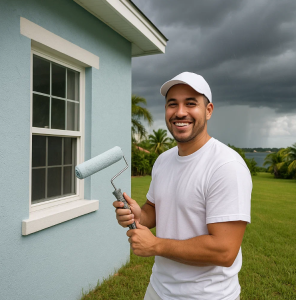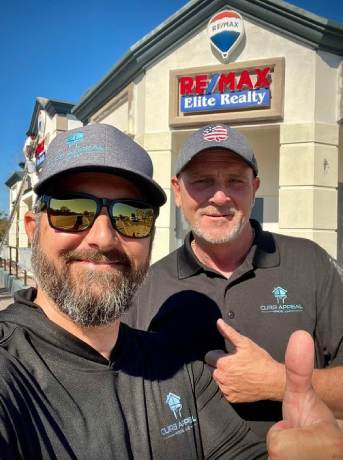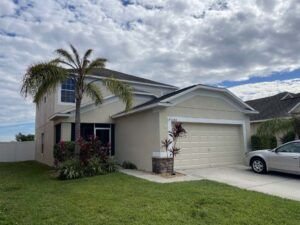Can Paint Protect My Home from Florida's Heavy Rain and Sun?





 Living in Palm Harbor means enjoying sun-soaked days, coastal breezes, and lush tropical surroundings. But it also means contending with relentless UV rays, heavy rains, high humidity, and salt-laden air. These environmental conditions take a toll on your home’s exterior—and that’s where high-quality paint plays a surprisingly powerful role. A knowledgeable Palm Harbor FL Painting Contractor will tell you that choosing the right paint system doesn’t just beautify your home—it protects it.
Living in Palm Harbor means enjoying sun-soaked days, coastal breezes, and lush tropical surroundings. But it also means contending with relentless UV rays, heavy rains, high humidity, and salt-laden air. These environmental conditions take a toll on your home’s exterior—and that’s where high-quality paint plays a surprisingly powerful role. A knowledgeable Palm Harbor FL Painting Contractor will tell you that choosing the right paint system doesn’t just beautify your home—it protects it.
In this comprehensive guide, we’ll explore how modern paint formulations are designed not just for aesthetics but for shielding your home from Florida’s toughest weather challenges. You’ll learn how paint acts as a first line of defense, the best products and techniques for protection, and what to look for when selecting weatherproof coatings that truly stand the test of time.
Why Paint Matters More in Florida’s Climate
Unlike milder regions, homes in Palm Harbor face extreme environmental stress:
- High humidity accelerates the growth of mold, mildew, and algae.
- Heavy rainfall can lead to water intrusion, wood rot, and paint blistering.
- UV exposure causes fading, chalking, and breakdown of surface materials.
- Salt air corrodes metal, degrades wood, and weakens film integrity.
Paint is not just for color—it’s a barrier. It forms a flexible, breathable, and waterproof layer that prevents moisture, UV light, and salt from damaging your home’s siding, trim, and exterior details.
How Paint Protects Against Sun and UV Damage
🌞 Florida’s UV Intensity
Florida ranks among the highest in UV index across the U.S. Prolonged exposure to direct sunlight doesn’t just fade colors—it breaks down the molecular structure of paint, causing it to crack, peel, or chalk over time.
🔒 Paint as a UV Shield
High-performance paints are engineered with UV inhibitors and reflective pigments that:
- Reflect rather than absorb solar heat
- Prevent fading and discoloration
- Reduce surface temperature and thermal stress
- Slow the breakdown of siding and substrates beneath
100% acrylic latex paints are especially effective in Florida. They offer high UV resistance and retain color vibrancy much longer than traditional oil-based options.
How Paint Protects Against Rain and Moisture
🌧️ Florida’s Rainfall Statistics
Palm Harbor experiences frequent thunderstorms, tropical downpours, and hurricanes. All that rain means constant exposure to water, which leads to:
- Mold and mildew growth
- Peeling or blistering paint
- Wood swelling or rotting
- Cracked stucco or efflorescence (salt deposits)
🛡️ Waterproof Paint Technology
The best exterior paints for Florida have features like:
- Elastomeric resins that stretch and seal hairline cracks
- Micro-porous finishes that allow water vapor to escape while preventing water from entering
- Mildewcides and algaecides to deter growth on damp surfaces
- Hydrophobic coatings that cause water to bead and roll off
When properly applied by a Palm Harbor FL Painting Contractor, these paints form a watertight but breathable membrane, keeping walls dry and protected.
Paint and Coastal Salt Air: A Hidden Threat
Palm Harbor’s proximity to the Gulf means most homes are exposed to salt-laden air—a silent and persistent enemy to exterior surfaces.
Problems Salt Causes:
- Corrosion of metal fixtures and fasteners
- Accelerated wear on paint films
- Penetration into porous surfaces like wood or stucco
Protective Paint Solutions:
- Use marine-grade primers and sealants on metal elements
- Choose alkali-resistant primers for stucco
- Wash surfaces annually to remove salt buildup
- Apply multiple coats of premium exterior latex paint to create a durable shell
Most Vulnerable Areas of the Home
Paint protection is especially critical in the following areas:
|
Area |
Why It’s Vulnerable |
Recommended Paint Type |
|
South- and west-facing walls |
Maximum UV exposure |
100% acrylic latex with UV blockers |
|
Window sills and trim |
Collects moisture, direct sun, and salt |
Semi-gloss mildew-resistant enamel |
|
Soffits and eaves |
Trap humidity and rain splashback |
Satin or semi-gloss paint with anti-mildew additives |
|
Stucco exteriors |
Absorbs moisture; prone to cracking |
Elastomeric or breathable acrylic |
|
Wood siding |
Swells and contracts with moisture |
Flexible latex with primer base |
How Long Will Protective Paint Last in Florida?
With the right preparation, products, and application:
- Exterior paint on stucco can last 8–10 years
- Wood siding typically needs repainting every 5–7 years
- Trim and doors may need refreshing every 3–5 years
- Metal surfaces protected with rust-inhibitive primer and topcoat can last 5–8 years
Florida’s conditions demand more frequent upkeep than other states, but using the right materials can greatly extend those lifespans.
The Importance of Surface Preparation
No matter how advanced the paint is, it won’t stick or perform well on dirty, damaged, or moist surfaces.
Essential Prep Steps:
- Pressure washing to remove dirt, algae, and salt residue
- Caulking gaps and cracks to seal moisture entry points
- Scraping and sanding peeling or blistered areas
- Priming bare or porous surfaces for better adhesion
- Drying time before and after cleaning (24–48 hours minimum)
A professional Palm Harbor FL Painting Contractor will complete all prep steps thoroughly, ensuring your protective coating adheres properly and performs to spec.
Best Exterior Paints for Florida Weather
Here are some top-rated paints designed to perform in the harshest Florida conditions:
- Sherwin-Williams Duration® Exterior
- UV-resistant, mildew-proof, and long-lasting
- UV-resistant, mildew-proof, and long-lasting
- Benjamin Moore Aura® Exterior
- ColorLock® technology for fade resistance
- ColorLock® technology for fade resistance
- Behr Marquee® Exterior
- Advanced dirt and water resistance
- Advanced dirt and water resistance
- PPG Permanizer®
- Designed specifically for coastal and high-humidity climates
- Designed specifically for coastal and high-humidity climates
Can Paint Reduce Cooling Costs?
Yes! Reflective paints and lighter color palettes can reduce the surface temperature of your home’s exterior walls and roof. That means:
- Less heat entering your home
- Reduced strain on your HVAC system
- Lower energy bills during summer months
Look for “cool roof” coatings or solar-reflective exterior paints when repainting roofs, siding, or overhangs.
Pro Tips for Maximum Paint Protection
- Inspect annually. Look for early signs of wear: cracks, bubbling, mildew, or fading.
- Wash your exterior at least once a year to remove salt, dirt, and mildew.
- Trim back landscaping to reduce moisture accumulation against walls.
- Repaint on schedule—don’t wait until paint fails completely.
- Work with a licensed contractor who understands Florida’s climate and recommends region-specific products.
The Role of a Professional Painting Contractor
An experienced Palm Harbor FL Painting Contractor doesn’t just apply paint—they evaluate your home’s vulnerabilities, recommend the best coatings, and apply them with precision. They also:
- Know how to time projects around Florida’s weather
- Use advanced tools for prep and application
- Identify and repair hidden damage before it worsens
- Guarantee their work for peace of mind
Paint as a Weather Barrier
In Florida, painting is not a cosmetic luxury—it’s essential protection for your home. From blinding sunshine to driving rain and corrosive salt air, Palm Harbor homes face constant exposure to elements that can degrade your property. Investing in quality exterior paint and professional application creates a weatherproof envelope that safeguards your investment for years to come.
Don’t underestimate the power of a brush and bucket—especially when guided by a skilled Palm Harbor FL Painting Contractor.
Coming Up Next:
Wondering what kind of quote to expect before the work begins? Stay tuned for our next post, What Should I Expect from a Painting Contractor’s Estimate in Palm Harbor?—where we break down typical costs, what’s included, and how to avoid surprises.

100% Satisfaction Guarantee

Licensed and Insured

Color Consultation

3 Year Warranty
Services

Our team of experts does popcorn ceiling removal and wallpaper removal. We also do drywall and stucco repairs as well as texturing, soffit and fascia repair.
Painting Service Locations

How long does it take to paint my house?
What is included with your free estimate?
All of our estimates include a fully detailed scope of the work to be completed. You will receive a report with a breakdown of the cost and time estimated for your project.
How do I get my project scheduled?
Simply follow the steps in the estimate to schedule or give us a call, text, or email. Whichever is convenient for you works for us.
Why does a house have to be pressure washed before painting?
If you’re planning to paint the exterior of your home, you may be wondering why pressure washing is such an important step. After all, a little dirt and grime shouldn’t stop the paint from sticking, right? Unfortunately, it’s not that simple. Over time, dirt, mildew, and other pollutants can build up on the surface of your home, causing the paint to chip and peel. Pressure washing removes this build-up, giving the new paint a clean surface to adhere to. In addition, pressure washing also helps to remove any chalky residue left behind by old paint. This ensures that the new paint will have a smooth, even finish. For these reasons, it’s always best to have your home professionally pressure washed before painting
Item How often does a house need to be repainted?
The frequency with which a house exterior needs to be repainted depends on a number of factors, including the type of paint used, the climate, and the level of exposure to sun and rain. In general, however, most experts recommend repainting every three to five years. High-quality paints that are properly applied can last for about 10 years, while lower-quality paints may last less. The climate also plays a role in how often a house needs to be repainted. For example, homes in areas with high humidity levels may need to be repainted more frequently than homes in dry climates. Exposure to sun and rain can also shorten the lifespan of paint, so homes that are exposed to these elements may need to be repainted more often than those that are not. Ultimately, the best way to determine how often a house exterior needs to be repainted is to consult with a painting contractor who can assess the condition of the paint and make a recommendation based on individual circumstances.
Trustindex verifies that the original source of the review is Google. I want to thank Curb Appeal Pros for doing an amazing job of painting the exterior of my house. Sending a big shout out to owner, Jay McGarrity, for being so patient, professional, and fair with the pricing, timing, and color choices. When I changed my mind about the original colors that I had selected, Jay came back to my house twice (including Father's Day) to test some different paint samples I had purchased from Sherwin Williams. The final result was exactly what I wanted and my house looks fabulous! I will hire Curb Appeal Pros again when I am ready to have some interior painting done.Trustindex verifies that the original source of the review is Google. They repaired stucco on the fireplace exterior and outside window sills, pressure washed the house, and my shed in the backyard. Painted the house and all fascia and soffits. They did an outstanding job !! Would not hesitate to use them again.Trustindex verifies that the original source of the review is Google. Amazing job filled in all the settling cracks and made the house look amazing would highly recommend them to anyone who’s looking to fix their home up.Trustindex verifies that the original source of the review is Google. What a great experience. Joey worked with me to get the house painted in between projects so I could have the house painted before my new gutters were put in. I didn't have to be home, which was a plus. The painter Angel and Nathen which I got meet at the end of the project were friendly and professional. I would definitely recommend Curb Appeal. Joyce Walter.Trustindex verifies that the original source of the review is Google. We recently hired Curb Appeal Pros to paint our living room,dining room, family room and kitchen. They were easily up to the task. I had different colors,different paint finish’s, texturing and an accent wall as well. Angel and his crew did an amazing job.They were organized ,pleasant ,and had my entire house finished in less than 3 days. They removed all the large furniture and carefully put it back in its place perfectly after the job was done ! The owner was hands on and was easy to reach and made sure that my questions were answered without delay or hesitation. My house looks amazing . They went the extra mile in every way and we are so grateful . Thank you Curb Appeal for a job well done. I recommend you contact them for all your painting needs.Trustindex verifies that the original source of the review is Google. Curb Appeal Pros is a 'one stop shop'. They recently painted our house and installed ledger stone on the exterior of our house. After the job was completed, we contacted Jay McGarrity about a detail. Jay immediately responded and came back to the house even after payment! The end result of their work is beautiful. Jay and his Team are a pleasure to work with.Trustindex verifies that the original source of the review is Google. reliable, great work, honest pricing. i highly recommend these pplTrustindex verifies that the original source of the review is Google. Fair price and good work. What more can you ask for?Trustindex verifies that the original source of the review is Google. Excellent job. Jay was quick to respond to everything we asked, kept us well informed and made sure the job was done exactly how we asked. Will definitely recommend to everyone who asks, which we have already done several times as of this review. Truly thankful for the professionalism when so many companies now lack it!
Request An Estimate

copyright @2025 all rights reserved | Privacy-policy